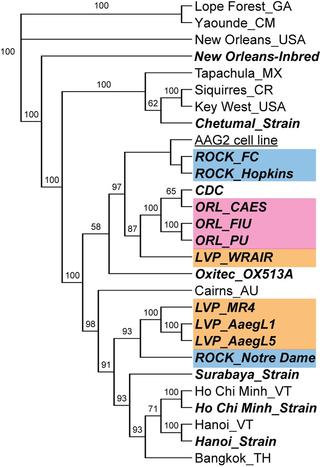当前位置:
X-MOL 学术
›
PLOS Negl. Trop. Dis.
›
论文详情
Our official English website, www.x-mol.net, welcomes your
feedback! (Note: you will need to create a separate account there.)
Genetic diversity of laboratory strains and implications for research: The case of Aedes aegypti.
PLOS Neglected Tropical Diseases ( IF 3.4 ) Pub Date : 2019-12-09 , DOI: 10.1371/journal.pntd.0007930 Andrea Gloria-Soria 1 , John Soghigian 1 , David Kellner 1 , Jeffrey R Powell 1
PLOS Neglected Tropical Diseases ( IF 3.4 ) Pub Date : 2019-12-09 , DOI: 10.1371/journal.pntd.0007930 Andrea Gloria-Soria 1 , John Soghigian 1 , David Kellner 1 , Jeffrey R Powell 1
Affiliation

|
The yellow fever mosquito (Aedes aegypti), is the primary vector of dengue, Zika, and chikungunya fever, among other arboviral diseases. It is also a popular laboratory model in vector biology due to its ease of rearing and manipulation in the lab. Established laboratory strains have been used worldwide in thousands of studies for decades. Laboratory evolution of reference strains and contamination among strains are potential severe problems that could dramatically change experimental outcomes and thus is a concern in vector biology. We analyzed laboratory and field colonies of Ae. aegypti and an Ae. aegypti-derived cell line (Aag2) using 12 microsatellites and ~20,000 SNPs to determine the extent of divergence among laboratory strains and relationships to their wild relatives. We found that 1) laboratory populations are less genetically variable than their field counterparts; 2) colonies bearing the same name obtained from different laboratories may be highly divergent; 3) present genetic composition of the LVP strain used as the genome reference is incompatible with its presumed origin; 4) we document changes in two wild caught colonies over ~16 generations of colonization; and 5) the Aag2 Ae. aegypti cell line has experienced minimal genetic changes within and across laboratories. These results illustrate the degree of variability within and among strains of Ae. aegypti, with implications for cross-study comparisons, and highlight the need of a common mosquito repository and the implementation of strain validation tools.
中文翻译:

实验室菌株的遗传多样性及其对研究的影响:以埃及伊蚊为例。
黄热病蚊子(埃及伊蚊)是登革热、寨卡病毒和基孔肯雅热以及其他虫媒病毒疾病的主要传播媒介。由于其易于在实验室中饲养和操作,它也是载体生物学中流行的实验室模型。几十年来,已建立的实验室菌株已在全世界数千项研究中使用。参考菌株的实验室进化和菌株之间的污染是潜在的严重问题,可能会极大地改变实验结果,因此是载体生物学的一个关注点。我们分析了实验室和野外的伊蚊菌落。埃及伊蚊和伊蚊。埃及伊源细胞系 (Aag2) 使用 12 个微卫星和约 20,000 个 SNP 来确定实验室菌株之间的分歧程度以及与其野生近缘种的关系。我们发现:1)实验室人群的遗传变异小于现场人群;2) 不同实验室获得的同名菌落可能存在很大差异;3) 用作基因组参考的 LVP 菌株目前的遗传组成与其推测的起源不相容;4) 我们记录了两个野生捕获群体在约 16 代殖民过程中的变化;5) Aag2 Ae。埃及伊蚊细胞系在实验室内部和实验室之间经历了最小的遗传变化。这些结果说明了伊蚊菌株内部和菌株之间的变异程度。埃及伊蚊,对交叉研究比较具有影响,并强调需要一个共同的蚊子储存库和实施菌株验证工具。
更新日期:2019-12-11
中文翻译:

实验室菌株的遗传多样性及其对研究的影响:以埃及伊蚊为例。
黄热病蚊子(埃及伊蚊)是登革热、寨卡病毒和基孔肯雅热以及其他虫媒病毒疾病的主要传播媒介。由于其易于在实验室中饲养和操作,它也是载体生物学中流行的实验室模型。几十年来,已建立的实验室菌株已在全世界数千项研究中使用。参考菌株的实验室进化和菌株之间的污染是潜在的严重问题,可能会极大地改变实验结果,因此是载体生物学的一个关注点。我们分析了实验室和野外的伊蚊菌落。埃及伊蚊和伊蚊。埃及伊源细胞系 (Aag2) 使用 12 个微卫星和约 20,000 个 SNP 来确定实验室菌株之间的分歧程度以及与其野生近缘种的关系。我们发现:1)实验室人群的遗传变异小于现场人群;2) 不同实验室获得的同名菌落可能存在很大差异;3) 用作基因组参考的 LVP 菌株目前的遗传组成与其推测的起源不相容;4) 我们记录了两个野生捕获群体在约 16 代殖民过程中的变化;5) Aag2 Ae。埃及伊蚊细胞系在实验室内部和实验室之间经历了最小的遗传变化。这些结果说明了伊蚊菌株内部和菌株之间的变异程度。埃及伊蚊,对交叉研究比较具有影响,并强调需要一个共同的蚊子储存库和实施菌株验证工具。











































 京公网安备 11010802027423号
京公网安备 11010802027423号